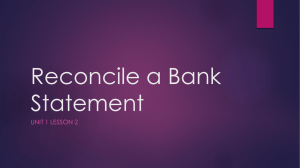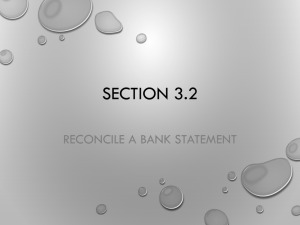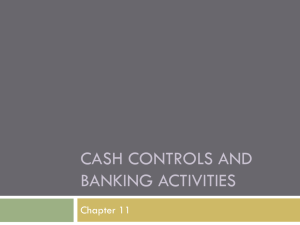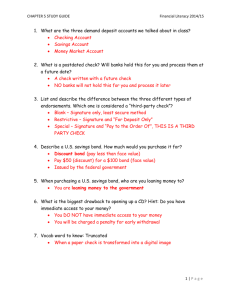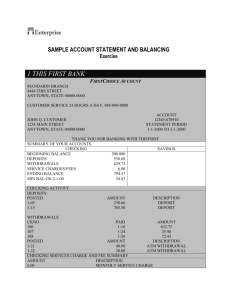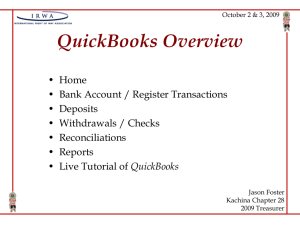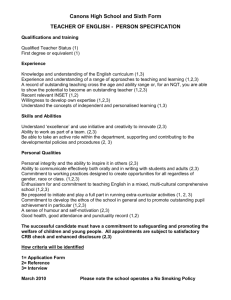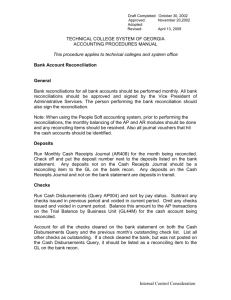FCS 7.9 Reconcile Checking Account
advertisement
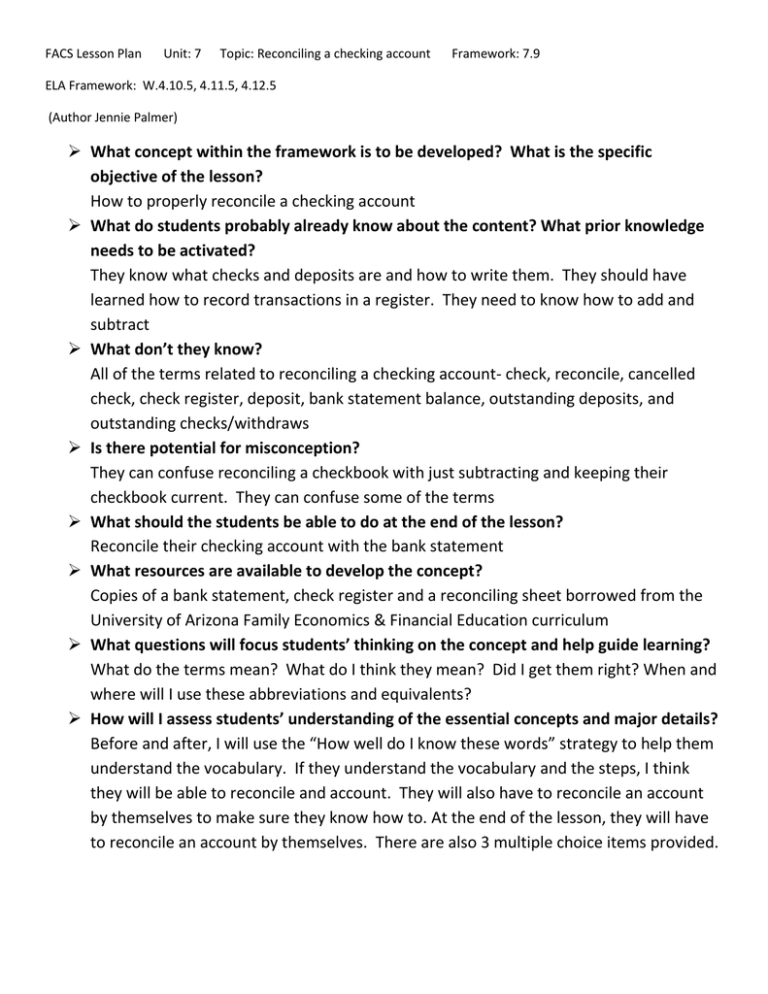
FACS Lesson Plan Unit: 7 Topic: Reconciling a checking account Framework: 7.9 ELA Framework: W.4.10.5, 4.11.5, 4.12.5 (Author Jennie Palmer) What concept within the framework is to be developed? What is the specific objective of the lesson? How to properly reconcile a checking account What do students probably already know about the content? What prior knowledge needs to be activated? They know what checks and deposits are and how to write them. They should have learned how to record transactions in a register. They need to know how to add and subtract What don’t they know? All of the terms related to reconciling a checking account- check, reconcile, cancelled check, check register, deposit, bank statement balance, outstanding deposits, and outstanding checks/withdraws Is there potential for misconception? They can confuse reconciling a checkbook with just subtracting and keeping their checkbook current. They can confuse some of the terms What should the students be able to do at the end of the lesson? Reconcile their checking account with the bank statement What resources are available to develop the concept? Copies of a bank statement, check register and a reconciling sheet borrowed from the University of Arizona Family Economics & Financial Education curriculum What questions will focus students’ thinking on the concept and help guide learning? What do the terms mean? What do I think they mean? Did I get them right? When and where will I use these abbreviations and equivalents? How will I assess students’ understanding of the essential concepts and major details? Before and after, I will use the “How well do I know these words” strategy to help them understand the vocabulary. If they understand the vocabulary and the steps, I think they will be able to reconcile and account. They will also have to reconcile an account by themselves to make sure they know how to. At the end of the lesson, they will have to reconcile an account by themselves. There are also 3 multiple choice items provided. Part of Lesson Strategy What Students Will Do How well do I know these words Use the worksheet to rate how well they know the vocabulary words. Read the words to them so they are pronounced right. Walk around and see how they are rating them. Cornell Notes Take notes on the vocabulary words. Take notes on the steps to reconcile a checking account Go over the vocabulary words with the kids Show them the steps to reconciling an account How well do I know these words Use the worksheet to rate the words now that we have gone over them. Have them reconcile an account on their own. Make sure they understand all of the words and go back over the ones that they don’t. Make sure they understand the steps and are doing them correctly. Before During After What Teachers Will Do How Well Do I Know These Words? Passage/Text: Reconciling A Checking Account Part I Directions: Read the words in the middle section of the page silently. After you read each one, write the words from the bottom of the page in the column that best describes what you know about the word. Discuss the words with your partner and move them to another column if possible. Don’t know at all Have seen or heard- don’t now meaning I think I know the meaning I know a meaning WORDS: check, reconcile, cancelled check, check register, deposit, bank statement balance, outstanding deposits, and outstanding checks/withdraws Part II Directions: As you read/listen and encounter the words, your understanding of the words should change. Write the words in the column that best describes what you know about the word after the lesson (s). I still need help understanding this word I think I know the meaning I know a meaning Vocabulary words Check- Used at the time of purchase as the form of payment. Piece of paper pre-printed with the account holder’s information on it. Reconcile- Balance the checkbook register each month to the balance shown on the bank statement cancelled check- Checks that have cleared the bank. check register- Place to record all monetary transactions (Deposits, checks, ATM use, debit card purchases, additional bank fees) for a checking account deposit- putting money into your account bank statement balance- the amount in your checking account according to your bank statement. outstanding deposits- deposits that have not cleared the bank yet. The deposits that are not on your bank statement. outstanding checks- checks that have not cleared the bank yet, they are not on your bank statement. outstanding withdraws- withdraws that have not cleared the bank yet, they are not on your bank statement. Steps to reconciling your bank account View the monthly bank statement and check register Place a check mark in the √ T column for all transactions that have been cleared and are shown on the bank statement Determine the current account balance from the bank statement Add any outstanding deposits – transactions that have not cleared the bank Subtract any outstanding withdrawals and calculate Compare the total with the checkbook register. If the totals are different, double check the math and make sure all service fees and bank charges are recorded in the check register. You can use a worksheet similar to this one for the steps: I am also attaching two different set of statements and registers borrowed from the University of Arizona FEFE curriculum. One is for practice and the other is for independent assessment. The one for practice I would give them as you are going over the steps and they can fill it out as you go. Possible multiple choice items: _____ 1. What does it mean when you balance the checkbook register each month to the balance shown on the bank statement a. Deposit b. Register c. Reconcile d. Check _____ 2. The total I get after I have reconciled my account should match the total that is a. in my check register b. on the bank statement c. the total of the outstanding deposits d. the total of the outstanding checks _____ 3. An outstanding check is one that a. has not been written b. has not cleared the bank c. has not been signed d. has not been dated
